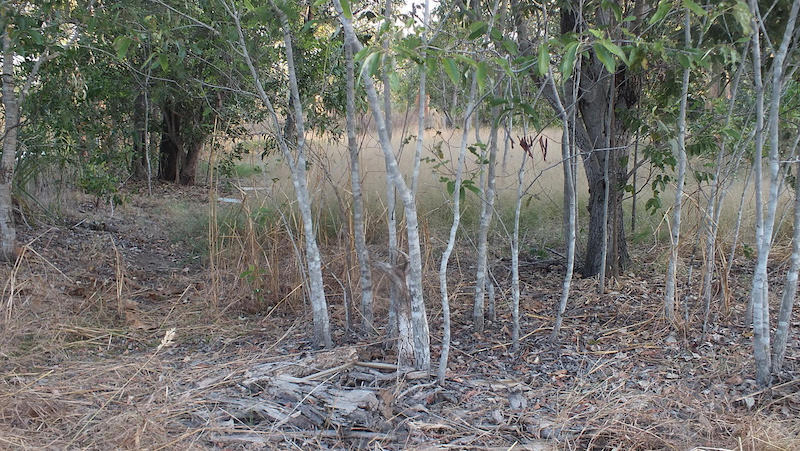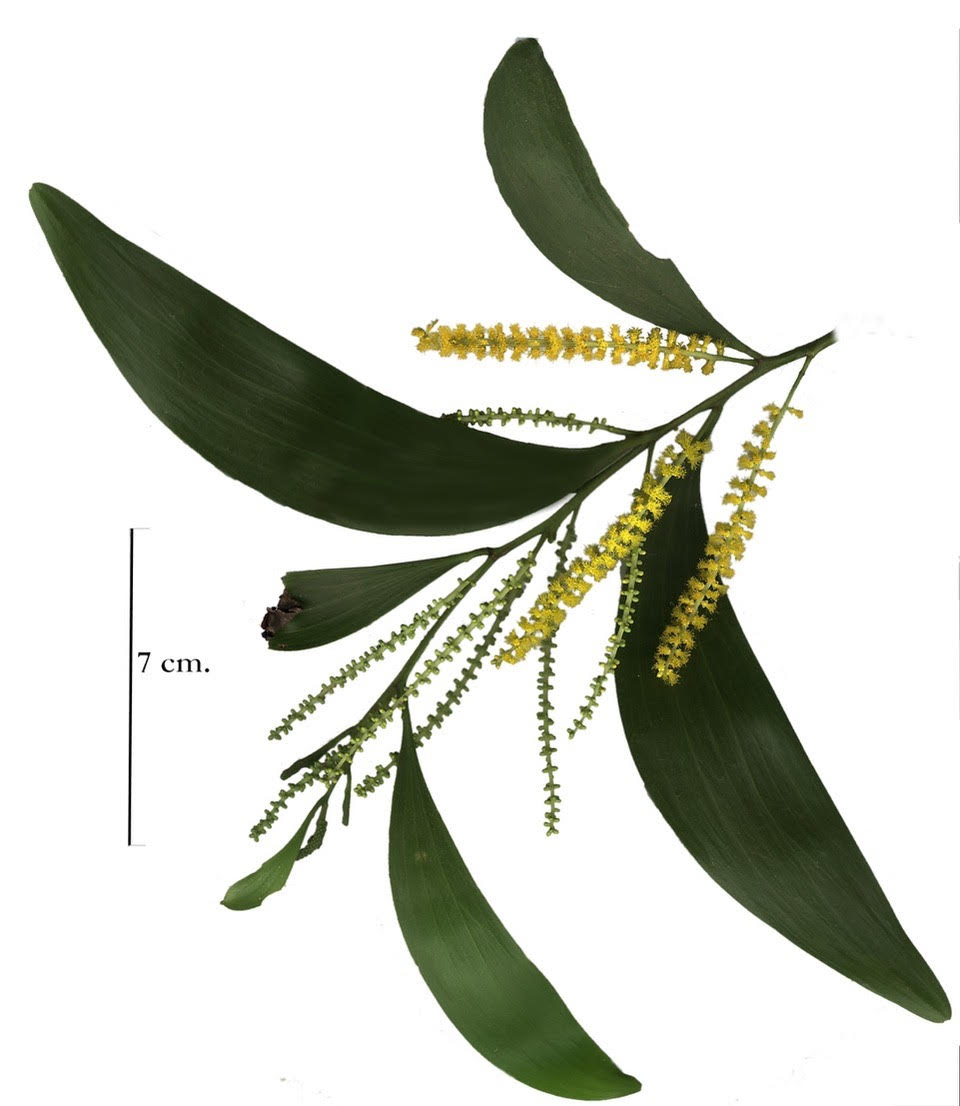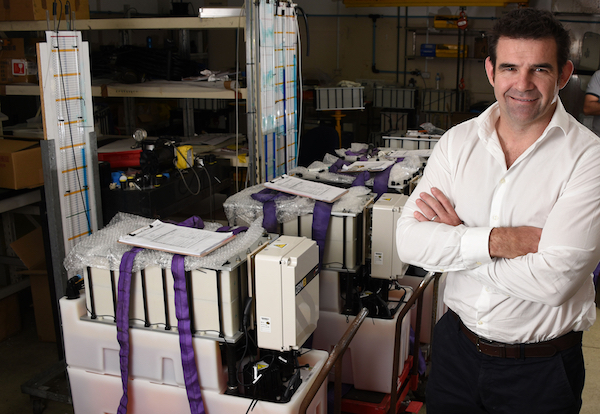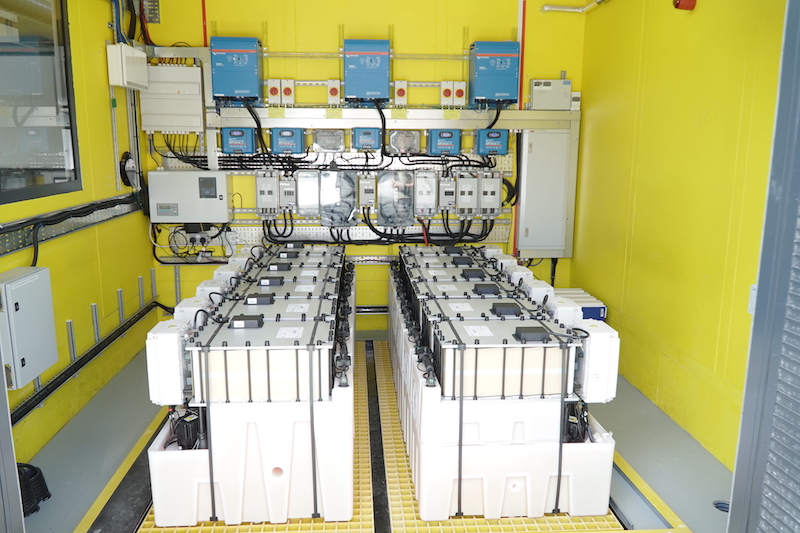Featured News
Newsroom
- Details
- In Denise Goodfellow
- /
Gamba grass (Andropogon gayanus) is a tall (4 metres high), multi-stemmed plant introduced to Australia in the 1930s as cattle fodder (Csurhes, 2005). The potential danger this grass posed was recognised early on, but despite assurances that it could be safely contained within paddocks heavily grazed by stock, gamba quickly escaped into surrounding savannah woodland (Petty, 2013) and elsewhere via “wind, water, animals and vehicles” (Beaumont, Keily & Kennedy, 2018). Now a weed of national significance gamba infests more than 1.5 million hectares of the Top End. The Top End is fast becoming a monoculture of gamba, and a ‘field of nightmares’ (Petty, 2013) for all concerned.
Gamba devastated the flora of woodland and even wetlands by crowding out trees and other plants, changing the nutrient status of the soil so that it better suits gamba than native vegetation, and fuelling wildfire so hot that even trees cannot survive - one study from Adelaide River 120 kms south of Darwin found 140 dead trees per hectare (Brooks, Setterfield & Douglas., 2010). A property near us lost 50-60% of it mature trees in one fire.
Gamba carries high-intensity crown fires more like those seen down south than the cool low fires once typical of the north. But unlike southern fires these Top End conflagrations can occur annually or ever more often (Kurucz, 2019). Every year our property southwest of Darwin Gamba won’t grow under these trees because of the saponins in their leaves is threatened at least once. Landholders have expressed both despair and fear at the amount of gamba grass infesting their land. We’re actually putting in a firegate at the east end of our property so that neighbours have an escape route should their property go up in flames. Tourists and locals alike have nearly died in gamba-fuelled fires.
Gamba won’t grow under these trees because of the saponins in their leaves is threatened at least once. Landholders have expressed both despair and fear at the amount of gamba grass infesting their land. We’re actually putting in a firegate at the east end of our property so that neighbours have an escape route should their property go up in flames. Tourists and locals alike have nearly died in gamba-fuelled fires.
- Details
- In Denise Goodfellow
- /
 Black wattle (Acacia auriculiformis) - ‘soap’ plants that have been long-used by Bininj
Black wattle (Acacia auriculiformis) - ‘soap’ plants that have been long-used by Bininj
A few months ago, a message appeared on Facebook. Posted by a family member living in Arnhem Land it told of the electrocution of a child. The women present did not administer CPR or call for medical assistance. Rather, they prayed over him.
When the coronavirus pandemic threatened there was another message from the same person, but the tone was more anxious this time. It consisted of a photograph of a woman praying and below the message in large letters that God and prayer would protect people from the coronavirus. As before several other women supported her post and they all sounded scared.
The juxtaposition of these two messages led me to fear that if COVID-19 did make it to Aboriginal settlements, prayer would be the first port of call, at least for some. An infectious diseases specialist friend has described the potential ramifications as ‘horrifying’.
- Details
- In Redflow
- /
 Redflow Managing Director and CEO Tim Harris
Redflow Managing Director and CEO Tim Harris
Australian energy storage company Redflow Limited (ASX: RFX) has received a subsequent order for its ZBM2 zinc-bromine flow batteries for deployment by New Zealand’s Rural Connectivity Group (RCG).
Redflow, which supplied an initial eight batteries for use by RCG in November 2019, has received a follow on order for an additional 10 batteries for installation at two new off-grid RCG telecommunications transmission towers in the North Island of New Zealand. Local RCG partner Switchboard Services has placed the order and will undertake ZBM2 installation works. This repeat order follows the successful installation and commissioning of Redflow’s ZBM2 batteries at two RCG towers late last year.
Redflow Managing Director and CEO Tim Harris said this order for ZBM2 batteries at further RCG sites demonstrated the benefits that Redflow’s zinc-bromine flow battery technology delivered to telecommunications companies. “These benefits include long-life performance, heat-tolerance and theft-resistance,” he said.
- Details
- In Redflow
- /

Swansea University, a research-led British university, has purchased Redflow’s unique ZBM2 zinc-bromine flow battery technology as the energy storage backbone for its Active Building demonstrator -– an award-winning classroom that generates, stores and releases solar energy at the point of use.
The microgrid is built around 120 kWh of Redflow batteries and is supplied with building-integrated, thin-film photovoltaic solar panels, as well as a solar wall that supplies the warm air to a heat-pump for space and water heating. Since being built, the classroom has proven the Active Buildings concept by generating more energy than it has used over an annual cycle, and during high solar summer months, the system will return power to the local electricity grid.
Redflow’s small 10 kWh flow battery units provided the only commercially available flow battery energy storage system that allowed accurate sizing for the 120 kWh system. Additionally, the Redflow battery operates “out of the box” with the Victron inverters and controllers that provide the power conversion for the Swansea University minigrid.
Tom Griffiths, Technology Transfer Fellow (Smart Systems), said Swansea selected the Redflow technology because of its ability to deliver 100% of the rated system energy every day, without degradation in capacity over a long – 10 year – life. “These characteristics were crucial considerations for us, and our application requires battery discharge duration of 4-8 hours depending on the time of year, making Redflow’s flow battery the ideal fit for our requirements in comparison to more conventional lead-acid or lithium alternatives.”
More News...
- Off-grid WA orchard beats bushfire blackouts with Redflow batteries (25 March 2020)
- Redflow batteries deliver 24-hour power and save $10,000 in diesel per year for off-grid WA station (05 February 2020)
- Fire flights over Adelaide Hills and KI create 3D maps of fire grounds for recovery and future safety planning (04 February 2020)
- Rural Connectivity Group chooses Redflow for off-grid energy storage in New Zealand (11 November 2019)
- Birds of Australia's Top End 2020 calendar raises money to fight gamba grass fuelled bushfires (10 November 2019)
- DDACL boosts productivity, patient care and staff morale after moving IT systems to Acurus (06 November 2019)
- New Redflow partner predicts battery boom as WA solar tariffs end (26 September 2019)
- Redflow receives order for ZBM2 batteries to power rural microgrid in North West Tasmania (29 August 2019)
- Adelaide hosts myth-busting conference on Albinism this weekend (20 August 2019)
- Gamba grass fires up threat to tourist safety in the Top End (13 August 2019)
Off the Cuff

Simon Hackett speaks about Formula E racing on ABC Radio Adelaide
Australian renewable energy investor Simon Hackett last week spoke to Radio ABC Adelaide's Afternoons host Sonya Feldhoff about the benefits for replacing the cancelled Adelaide 500 motor race with a...
Read more
Seven simple steps for mental health in time of coronavirus
After the summer bushfires, the coronavirus pandemic and associated economic shutdown, “unprecedented” must be a standout favourite for Macquarie Dictionary’s Word of the Year for 2020. For the first time...
Read more
John Harris talks (a bit) about International Albinism Awareness Day on ABC Radio
John Harris, who has the honorary role of PR guy for the Albinism Fellowship of Australia, was interviewed by Peter Goers on the Evenings show of ABC Radio Adelaide on...
Read more
Start-ups are key to the future of everything
Nigel Lake, Executive Chair of global business advisory firm Pottinger, will tell this week's Myriad start-ups festival in Brisbane, running May 16-19, that Australia needs start-ups to protect its prosperity. Pottinger...
Read moreContact
Impress Media Australia
P: +61 8 8431 4000
E: john@impress.com.au
W: www.impress.com.au
Street:
Impress Media Australia
313 Portrush Road,
Norwood SA 5067
Click here for our location
Postal:
Impress Media Australia
Box 95, Kensington Park
South Australia 5068







